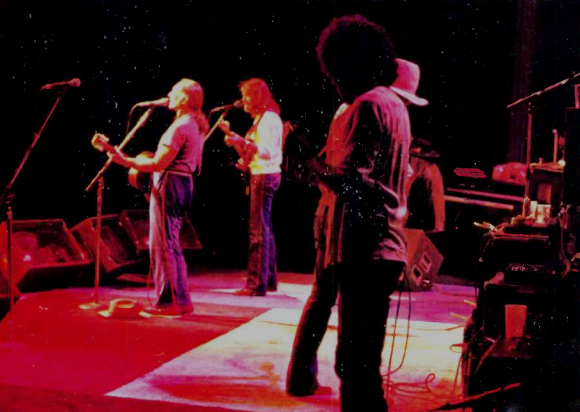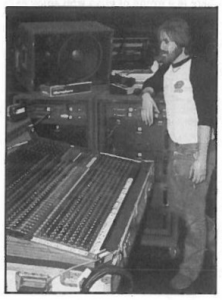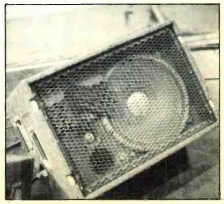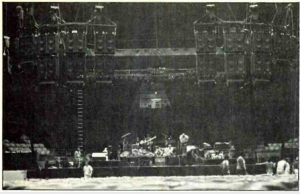
Stage Monitor System
Centered around a Gamble Model SC32-16 console, the stage monitoring system provided by Innovative Audio was remarkable for its lack of outboard equalization.
As Nelson’s monitor mixer, Pete Stauber explains, “This board has true parametric EQ on every input channel, and I have four-band parametric EQ onboard for each of the 16 output mixes. And there is an output switching matrix, which assigns any mix output to any of the XLR jacks on the back panel.
“So, if I have an opening act whose drummer is in a different part of the stage, I don’t have to run out there and move the drum monitor; I just pick the slant nearest him, hit the switch, it lights up, and Bingo! It’s taken care of.
“Also, I have built-in pink noise for equalizing the monitors. All I have to do is turn it on, and I even have a display for the spectrum analyzer.”
Innovative’s Gordon Jennings traces out the monitor signal path: “The mix output goes through the switching matrix to the back panel of the console.”
There, it is sent on to the amplifier racks, and then to floor slants using Cannon EPS connectors. “The monitor amp racks contain units able to deliver 600 watts into 4 ohms, or 350 watts in 8 ohms, per channel. We developed this amplifier in conjunction with Cerwin-Vega, because we needed a device with an ultra-high slew rate, and this one came out with a rate of 80 to 90 volts per microsecond; we use it in both the house and monitor systems.

“We use a ground running through the monitor board; the whole system is grounded there. All of our amp racks have no U-ground, no Edison ground. That way, if there is a ground loop, it is a loop which someone else has introduced which is foreign to our system.”
Stage microphone lines are fed into subsnake lines which terminate at the monitor board; the house console is then fed out directly from the monitor board.
Since the monitor board patchbay points are half-normaled, changing a patch at either the house or monitor console does not affect assignment at the other end.
Quick-disconnect strip connectors are used throughout the cabling system. According to David Morgan, this cabling scheme, combined with the single-point grounding concept, makes for a very quiet, noise-free system.

“You run the console wide open with lots of gain, and all you hear is a little bit of pure white noise from the electronics . . . absolutely no hum,” he claims.
Monitor Speakers
A total of 11 floor slants were placed on stage for Nelson and the band. Six of the slants were located in the front line, spread directly across the downstage edge. Each box contained a single 15-inch JBL K130 (or E130), and a 2441 HF driver on a 2311 horn with a 2308 slant plate. Additionally, each unit had one JBL 2402 “bullets,” or high” frequency radiator. Nelson’s pair of floor slants, however, was equipped with 2482 drivers.

“It’s a sound he likes,” says Jennings. “He prefers the sharper mid-range sort of sound, go we always give him ‘82s.”
The monitor cabinets are bi-amplified, with the tweeters crossed over passively with an 8-ohm L-pad. The JBL 5234A electronic crossovers are backed by networks built by Innovative, utilizing LC/RC passive circuits to maintain accuracy and protection.
The speakers are covered with a utility-gray indoor-outdoor carpet, which rendered them practically immune to nicks and scratches. Protective face-plate covers are secured with Sessions latches, which had wheels on them; once the covers were in place, the monitor speakers were ready to roll off to the truck loading area.
Showco/lnnovative Cooperation
With two “competitive” sound companies on the road with the same act, I wondered whether there might be any friction between them.
“Absolutely not,” gays Showco’s representative Little Joe, who took care of hanging and checking out the house speaker system. “This really is like a family. We’re here not because the company said to be here, but because we all really want to be doing this gig.”
House engineer Mike Garvey echoes his sentiments. “This is almost a personality tour, you could say. A guy’s attitude is everything out here. It has sort of worked out that what we have here is a group of guys who enjoy each other’s company, and all happen to be very good at what they do. It works out to be a very smooth situation.”
Things did flow rather well on the tour. While this was a large arena show that I observed at the San Diego Sports Arena, the truck doors were not even opened until nearly 2 PM (although the rigging points already had been hung). After the lighting system had been raised, the monitor system was placed on stage and unpacked.
The house mix position had been set up while the PA chain-motor hoists were rigged. After the house speakers had been flown, the stage gear was placed, and the house and monitor systems checked out with the pink-noise generators built into the Gamble consoles. No sound check was deemed necessary, and most of the crew had plenty of time for a leisurely meal and some video games on the crew bus before the show.

The sound of the concert was exceptionally smooth; very few surprises. Nelson’s sharp-edged voice carried well all the way to back of the San Diego Sports Arena. The C’Ducer pickups made the acoustic piano stand out quite well, even though this particular arena is not noted for having exceptionally good acoustics for live music presentations. The Gamble consoles, the Innovative Audio monitors and the Showco pyramid speaker system comprised an excellent vehicle for presenting Willie Nelson’s voice and music to a capacity crowd in an acoustically-poor setting.
The Innovative Audio Speaker System
Although for the Nelson tour Innovative weren’t supplying speaker arrays, the company can handle full sound system contracts. David Morgan explains the company’s speaker systems concept: “Essentially, Innovative Audio evolved out of Tychobrahe, which used to be one of the world’s largest sound companies. When Tychobrahe was bought out, we took the old M-500 columns, which were one of the most common PA speakers of the early Seventies and overhauled them.
“The box used to consist of a three-o way direct-radiator cabinet which was loaded with two JBL speakers, two 2482 drivers on a 2309 horn, and two JBL bullets. We made the cabinet a sealed enclosure which does not go below 100 Hz, and replaced the woofers with new JBL 2220s. We added two more tweeters per box, and changed over to 2441 drivers, which made a big difference in the cabinet’s high-end response. Its crossover points are 1 kHz and 10 kHz. The system gets its low bass from our 4×18 subwoofer bins; they each contain four Cerwin-Vega 18-inch speakers (Figure 8).”
The subwoofer box is 54 inches wide, by 53 inches high, by 30 inches deep, and is a 37.5 cubic foot enclosure. Morgan also commented that the company has plans to do an A-B comparison of the Cerwin-Vega 18-inch speaker with the new JBL 2240, with a possible change in mind should test results point in that direction.
The Innovative Audio house speaker system gives every appearance of being well-suited for both hanging and stacking; the rectangular cabinets are deep enough to support a fairly high vertical stack if the need arises. Half-sized three-way cabinets exist for hanging from the bottom of the flying speaker assemblies; full-sized sub-woofer boxes are placed on the outer corners of the stage area.
The Innovative Audio speaker system is typically representative of today’s modular speaker systems; however, the company’s system electronics can be considered to be unique. The transformerless signal chain is one more step in the direction of cleaner, more transparent audio-frequency amplification. And Mike Garvey, of the Willie Nelson organization, is not alone in liking what he hears. This system also is in use by Toto, Jefferson Starship, and a growing list of other touring acts.
Editor’s Note: This is a series of articles from Recording Engineer/Producer (RE/P) magazine, which began publishing in 1970 under the direction of Publisher/Editor Martin Gallay. After a great run, RE/P ceased publishing in the early 1990s, yet its content is still much revered in the professional audio community. RE/P also published the first issues of Live Sound International magazine as a quarterly supplement, and LSI grew to become the monthly publication that continues to thrive to this day.
Our sincere thanks to Mark Gander for his considerable support on this archive project.
